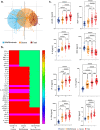A high-risk gut microbiota configuration associates with fatal hyperinflammatory immune and metabolic responses to SARS-CoV-2
- PMID: 35574937
- PMCID: PMC9116414
- DOI: 10.1080/19490976.2022.2073131
A high-risk gut microbiota configuration associates with fatal hyperinflammatory immune and metabolic responses to SARS-CoV-2
Abstract
Protection against severe acute respiratory syndrome coronavirus 2 (SARS-CoV-2) infection and associated clinical sequelae requires well-coordinated metabolic and immune responses that limit viral spread and promote recovery of damaged systems. However, the role of the gut microbiota in regulating these responses has not been thoroughly investigated. In order to identify mechanisms underpinning microbiota interactions with host immune and metabolic systems that influence coronavirus disease 2019 (COVID-19) outcomes, we performed a multi-omics analysis on hospitalized COVID-19 patients and compared those with the most severe outcome (i.e. death, n = 41) to those with severe non-fatal disease (n = 89), or mild/moderate disease (n = 42), that recovered. A distinct subset of 8 cytokines (e.g. TSLP) and 140 metabolites (e.g. quinolinate) in sera identified those with a fatal outcome to infection. In addition, elevated levels of multiple pathobionts and lower levels of protective or anti-inflammatory microbes were observed in the fecal microbiome of those with the poorest clinical outcomes. Weighted gene correlation network analysis (WGCNA) identified modules that associated severity-associated cytokines with tryptophan metabolism, coagulation-linked fibrinopeptides, and bile acids with multiple pathobionts, such as Enterococcus. In contrast, less severe clinical outcomes are associated with clusters of anti-inflammatory microbes such as Bifidobacterium or Ruminococcus, short chain fatty acids (SCFAs) and IL-17A. Our study uncovered distinct mechanistic modules that link host and microbiome processes with fatal outcomes to SARS-CoV-2 infection. These features may be useful to identify at risk individuals, but also highlight a role for the microbiome in modifying hyperinflammatory responses to SARS-CoV-2 and other infectious agents.
Keywords: COVID-19; Microbiota; cytokines; inflammation; metabolites; tryptophan.
Conflict of interest statement
LOM is a consultant to PrecisionBiotics and has received research funding from GSK and Chiesi. LOM has participated in speaker’s bureau for Nestle, Nutricia, Reckitt and Abbott. WCA has participated in advisory boards for Pfizer, MSD and Sanofi, with reimbursements paid to his institution. None of the other authors report any potential conflict of interest.
Figures





References
-
- Sokolowska M, Lukasik ZM, Agache I, Akdis CA, Akdis D, Akdis M, Barcik W, Brough HA, Eiwegger T, Eljaszewicz A, et al. Immunology of COVID-19: mechanisms, clinical outcome, diagnostics, and perspectives-A report of the European Academy of Allergy and Clinical Immunology (EAACI). Allergy. 2020;75(10):2445–2476. doi:10.1111/all.14462. - DOI - PMC - PubMed
Publication types
MeSH terms
Substances
LinkOut - more resources
Full Text Sources
Medical
Miscellaneous
